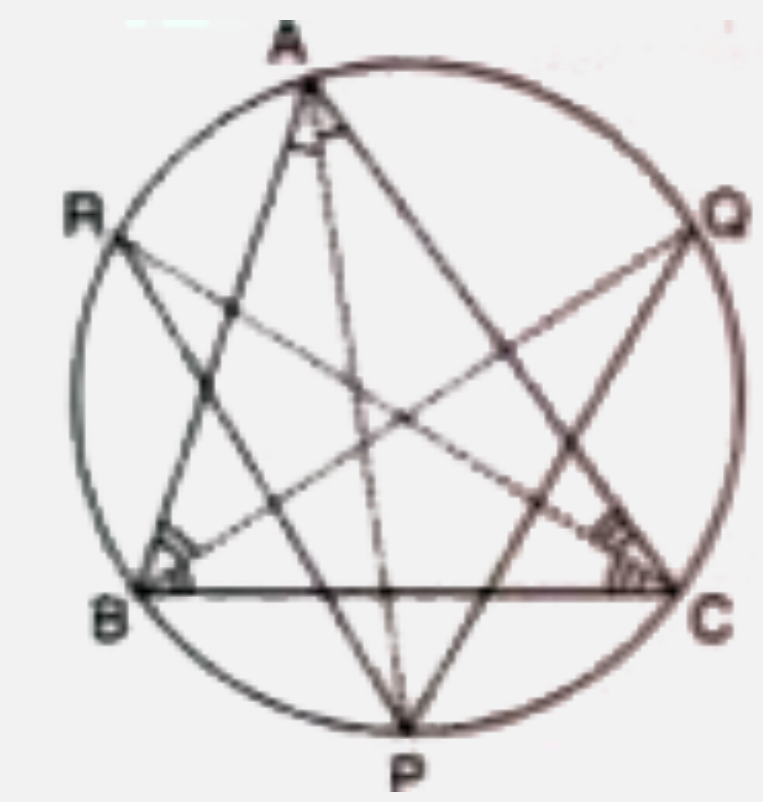Internal bisectors of ΔABC meet the circumcircle at point D, E, and F
Area of ΔDEF is
2R2cos2(A2)cos2(B2)cos2(C2)
2R2sin(A2)sin(B2)sin(C2)
2R2sin2(A2)sin2(B2sin2(C2)
2R2cos(A2)cos(B2)cos(C2)
The correct Answer is:D
To find the area of triangle DEF, formed by the internal bisectors of triangle ABC meeting the circumcircle, we can follow these steps:
Step 1: Understand the Geometry
We have triangle ABC with its internal angle bisectors intersecting the circumcircle at points D, E, and F. We need to find the area of triangle DEF.
Step 2: Use the Area Formula for Triangle ABC
The area of triangle ABC can be expressed using the formula:
AreaABC=abc4R
where a,b,c are the lengths of the sides opposite to angles A, B, and C respectively, and R is the circumradius of triangle ABC.
Step 3: Determine the Angles at Points D, E, and F
Using the properties of angle bisectors:
- Angle ABE = B2
- Angle ACD = C2
- Angle FDE = B+C2
Step 4: Apply the Sine Rule in Triangle DEF
By applying the sine rule in triangle DEF, we can express the sides in terms of the angles:
EFsin(FDE)=2R
Thus, we can find:
EF=2R⋅sin(FDE)
Step 5: Calculate the Area of Triangle DEF
The area of triangle DEF can be calculated using the formula:
AreaDEF=12×EF×h
where h is the height from point D to line EF.
Using the sine of the angles:
AreaDEF=2R2⋅sin(A+B2)⋅sin(C2)⋅sin(A+C2)
Step 6: Simplify the Area Expression
Using the product-to-sum identities, we can simplify the area expression:
AreaDEF=2R2⋅cos(A2)⋅cos(B2)⋅cos(C2)
Final Result
Thus, the area of triangle DEF is:
AreaDEF=2R2⋅cos(A2)⋅cos(B2)⋅cos(C2)
---
We have triangle ABC with its internal angle bisectors intersecting the circumcircle at points D, E, and F. We need to find the area of triangle DEF.
The area of triangle ABC can be expressed using the formula:
AreaABC=abc4R
where a,b,c are the lengths of the sides opposite to angles A, B, and C respectively, and R is the circumradius of triangle ABC.
Using the properties of angle bisectors:
- Angle ABE = B2
- Angle ACD = C2
- Angle FDE = B+C2
By applying the sine rule in triangle DEF, we can express the sides in terms of the angles:
EFsin(FDE)=2R
Thus, we can find:
EF=2R⋅sin(FDE)
The area of triangle DEF can be calculated using the formula:
AreaDEF=12×EF×h
where h is the height from point D to line EF.
AreaDEF=2R2⋅sin(A+B2)⋅sin(C2)⋅sin(A+C2)
Using the product-to-sum identities, we can simplify the area expression:
AreaDEF=2R2⋅cos(A2)⋅cos(B2)⋅cos(C2)
Thus, the area of triangle DEF is:
AreaDEF=2R2⋅cos(A2)⋅cos(B2)⋅cos(C2)
Topper's Solved these Questions
- PROPERTIES AND SOLUTIONS OF TRIANGLEBOOK - CENGAGE ENGLISHCHAPTER - PROPERTIES AND SOLUTIONS OF TRIANGLEEXERCISE - Matrix match type
6 Videos
- PROPERTIES AND SOLUTIONS OF TRIANGLEBOOK - CENGAGE ENGLISHCHAPTER - PROPERTIES AND SOLUTIONS OF TRIANGLEEXERCISE - Numerical value type
22 Videos
- PROPERTIES AND SOLUTIONS OF TRIANGLEBOOK - CENGAGE ENGLISHCHAPTER - PROPERTIES AND SOLUTIONS OF TRIANGLEEXERCISE - Multiple correct answer type
24 Videos
- PROGRESSION AND SERIESBOOK - CENGAGE ENGLISHCHAPTER - PROGRESSION AND SERIESEXERCISE - ARCHIVES (MATRIX MATCH TYPE )
1 Videos
- RELATIONS AND FUNCTIONSBOOK - CENGAGE ENGLISHCHAPTER - RELATIONS AND FUNCTIONSEXERCISE - Archives(Matrix Match Type)
1 Videos
Similar Questions
Internal angle bisecotors of ΔABC meets its circum circle at D, E and F where symbols have usual meaning.
Q. The ratio of area of triangle ABC and triangle DEF is :
View SolutionThe internal bisectors of the angles of a triangle ABC meet the sides in D, E, and F. Show that the area of the triangle DEF is equal to 2△abc(b+c)(c+a)(a+b), where △ is the area of ABC.
View SolutionThe given figure shows a triangle ABC with ∠BAC=56∘and∠ABC=64∘, Bisectors of angles A,B and C meet the circumcircle of the ΔABC at points P,Q and R respectively . Find the measure of ∠QPR.

View SolutionA(z1),B(z2) and C(z3) are the vertices of triangle ABC inscribed in the circle |z|=2,internal angle bisector of angle A meets the circumcircle again at D(z4).Point D is:
View SolutionBisectors of vertex angles A, B and C of a triangle ABC intersect its circumcircle at the points D,E and F respectively. Prove that angle EDF=90∘−12∠A
View SolutionIn ABC, the three bisectors of the angle A, B and C are extended to intersect the circumcircle at D,E and F respectively. Prove that ADcosA2+BEcosB2+CFcosC2=2R(sinA+sinB+sinC)
View SolutionIn triangle ABC, side AC is greater than side AB. If the internal bisector of angle A meets the opposite side at point D, prove that : ∠ADC is greater than ∠ADB.
View SolutionIn triangle ABC, side AC is greater than side AB. If the internal bisector of angle A meets the opposite side at point D, prove that : ∠ADC is greater than ∠ADB.
View SolutionIn TriangleABC with fixed length of BC, the internal bisector of angle C meets the side ABatD and the circumcircle at E . The maximum value of CD×DE is c2 (b) c22 (c) c24 (d) none of these
View SolutionIn TriangleABC with fixed length of BC, the internal bisector of angle C meets the side ABatD and the circumcircle at E . The maximum value of CD×DE is c2 (b) c22 (c) c24 (d) none of these
View Solution
